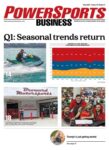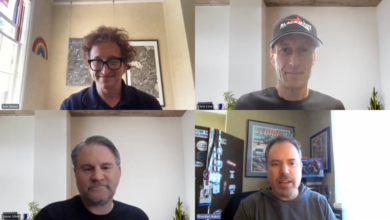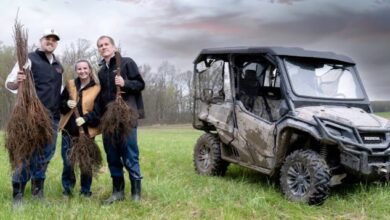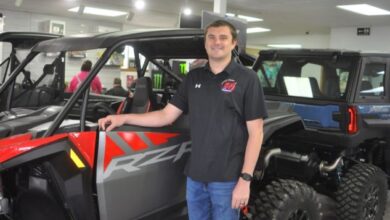May 4, 2009 – Executive of the year
By Neil Pascale
Editor
MEDINA, Minn. — On the second floor of Polaris Industries’ headquarters, tucked away on the back of Bennett Morgan’s office door, is a
T-shirt covered in two- and three-word phrases. The phrases, handwritten in blue ink, are so numerous that one seems to meld into another, with only the different styles of handwriting differentiating one from another.
The phrases are “Morganisms,” an expression that has come to symbolize the Polaris president’s penchant for creating words that are likely not found in the latest Merriam-Webster dictionary, but summarize a business situation in a clear, if not over-the-top fashion.
Such as “axe-murdered,” a Morganism that defines the effect on a company when it loses market share to a competitor.
Or “tip to tail,” a Morganism that explains a complete or top-to-bottom analysis or restructuring of a company’s processes.
Last year, thanks to a “tip-to-tail” reworking of Polaris’ operations, the Medina, Minn., manufacturer steered clear of any “axe-murdering,” finishing with a record year in sales and an increase in its net income. Those achievements, notable in any year, were all the more significant in an environment where many of the industry’s largest OEMs suffered double-digit percentage declines.
In explaining those achievements, Polaris executives point to the company’s operational excellence campaign, a multi-year process aimed at improving the OEM’s new unit quality and speed to market while also improving overall cost savings.
Morgan, the president and company’s chief operating officer, has been the “mastermind” behind this company-wide initiative, an effort that made the record year of 2008 possible, says Polaris CEO Scott Wine.
“It was the reason,” Wine said, putting special emphasis on the word “the.”
“It wasn’t like 50 percent significant, it was the reason. Because if you look at what drove the record results, it sure wasn’t ATVs.”
For Morgan’s leading role in Polaris’ operational excellence campaign and its resulting record-breaking impact, Powersports Business has named the longtime Polaris official the 2009 Executive of the Year.
Tip to tail
“Operational excellence” has become the catch-all phrase Polaris uses to describe its effort at reworking many of its key processes and systems. Simply put, the company has sought to improve each facet of its business, from the conception of a vehicle idea to how then it is designed and developed internally to how its manufactured and finally, how its retailed. Part of this process meant re-examining how Polaris worked with its partners, both its manufacturing suppliers and its dealer network.
In large measure, the overarching goal was simple: achieve more flexibility. More flexibility from its suppliers that would in turn allow for more flexibility on its manufacturing lines. And as a result, more flexibility in dealer ordering.
Of course, achieving any or all of that meant huge fundamental changes.
“That’s the difficulty,” Morgan said of making a change to one part of Polaris’ system. “To reinvent it, we had to change capabilities throughout our entire system. We couldn’t just say, ‘Let’s just change how often we take orders from our dealers.’ Dealers would like that, but they would be frustrated pretty quickly because we couldn’t execute it appropriately.”
But by diving into each of the needed areas, Morgan and his staff — “it’s an awesome team,” he says — have made sizeable leaps in several measurable areas. The company’s speed to market, how quickly it can introduce new models to the marketplace, improved 15 percent in 2008 vs. the prior year and is now 36 percent faster than two years ago. Plus, the company has reduced its supply chain lead times by
50 percent. This has allowed the company to have a more flexible manufacturing process — the company now has mixed model capability in each of its production lines — and phase in a new dealer distribution program. This latest effort, still in its infancy, has turned ordering from a twice-a-year event to something that occurs biweekly, a huge step toward satisfying market demand and as a result, increasing market share.
“Like I said, it’s not significant,” Wine said of the company’s operational excellence initiative. “It’s the reason we were able to have a record year in this environment.
“Bennett has been the mastermind of executing this the last couple of years, and it was great to see it all come together in 2008 in such a good way.”
The origin
Much of what was accomplished in the operational excellence initiative in 2008 began after what some in the company viewed as a lackluster 2005. The company finished that year up in sales and net income, but it paled in comparison to the previous couple of years. Polaris’ net income rose 12 percent in 2003 then jumped even higher the following year. Although 2005 marked the company’s 24th consecutive year of record earnings, the growth of the company’s net income slowed considerably.
“We frankly weren’t thrilled with how we were performing,” Morgan said, recalling the birth of the operational excellence initiative.
“Coming out of 2005-’06, we thought we had gotten a little fat. We thought we got slow by our standards. We thought we had become a little bit more one-dimensional from how we were handling some of our relationships with our stakeholders. And we said, ‘We can do better.’”
The desire to improve wasn’t so much on the innovation side, as the company continued to pour money into its R&D department, including in the category that would emerge as an absolute key to its profitable 2008: side-by-sides. Instead the company looked at ways to bring its innovation to the marketplace quicker.
“You might have great innovation, but if you’re a year or two slow, it’s far less interesting to the consumers and the dealers,” Morgan said.
Part of achieving that was focusing on a new standard in which to measure the company.
Net Promoter
“What gets measured is what gets done,” Morgan said.
For Polaris’ operational excellence initiative, the company started measuring a new metric, a “Net Promoter” score. This method asks consumers, on a scale of 1-10, if they would be willing to recommend a Polaris product to a friend. Consumers who mark a 9 or 10 are believed to be promoters of the brand. Those who give an 8, 7 or 6 score are considered passive — neither helping nor hurting the company — while the rest (those scoring 5 and under) are considered to be detractors. The number of promoters minus the number of detractors provides a Net Promoter score.
“It really changes the focus to a much, much broader thing on quality,” Morgan said. “You’re not just worried: ‘Is the vehicle right? How does your warranty look?’ You look at your whole system’s wide array of activities.
“It does change how you go about trying to develop the highest quality product in the world.”
Polaris started using this customer survey system in 2007. Although the company does not sample every one of its new unit customers, Morgan says Polaris is expanding its frequency of surveying. It also looks at the competition.
“We have mechanisms where we try to do that,” he said. “It’s obviously not as simple with your own database.”
According to an online earnings report, Polaris’ Net Promoter score ranks first in the industry for motorcycles and side-by-sides and middle of the pack for ATVs and snowmobiles. Three of the four vehicle categories showed improvements last year over 2007, including a 20 percent jump for snowmobiles.
“There’s a reasonable amount of data that shows if you drive customer satisfaction and customer loyalty over time, almost all of our stakeholders are going to benefit, including our shareholders,” Morgan said.
Speed to market
One key to driving brand loyalty: Ensuring customers can get the latest, greatest technology from the brand they know best.
Understanding this, Polaris examined its internal R&D processes as part of its operational excellence initiative. “We’re not taking any more risks,” Morgan said of the company’s R&D changes. “What we did was take out the non value-added waste.”
That included areas where the company had redundancies in R&D processes, people or both. “We looked at areas that we could do things concurrently rather than sequentially in the product development process,” he said. “We were able to drive out more than 30 percent of our product development time and that makes a big difference.”
Polaris also took a more refined look at what to update on a new model year vehicle. Morgan uses a recent Sportsman XP model, which the company had advertised as being “99 percent new,” as an example.
“Well, in lots of cases, customers didn’t dislike everything about the old Sportsman,” Morgan said. “So if you’re doing something to do new just to do it new, you’re adding time, you’re adding complexity, you’re adding risk and it’s waste.
“That’s another huge, huge caveat if you look at what we’ve done. We’re focusing (Polaris’ efforts) based on the voice of the customer. What is the innovation they need? Then focusing on that and not focusing on doing things that they don’t need.”
Wine, Polaris’ CEO, hails the speed-to-market part of the overall operational excellence initiative as crucial. “Look how quickly they got the RZR S to market,” he said. “We were not only able to get the product to market in
12 months, but to shift production to ATVs to side-by-sides on very short order.”
In fact, Polaris executives point to several 2009 model-year vehicles — including the RZR S, Ranger Crew and RZR 170 — that would not have made it to the showroom floor in previous years without these speed-to-market initiatives.
Manufacturing flexibility
At the same time Polaris looked internally to improve its speed to market, it also was identifying external factors that would prove equally critical.
“Our supply chain lead times were too long,” Morgan said.
So the company worked with its suppliers to find ways they could lessen supply chain lead times via lean manufacturing processes that could help the supplier eliminate waste and thus improve profit.
“If it’s all about us getting faster by asking our supply chain to take more risk or put more inventory somewhere so they can respond to our needs, that probably doesn’t work long term,” Morgan said.
Part of this process included the development of a supplier council, a group of suppliers that meets monthly to develop best practices in lean manufacturing. The meetings include a diverse group of companies, including SunWest Screen Graphics. Joe Novak, the company’s chief operating officer, calls the meetings “a shared learning opportunity” for both the suppliers and Polaris.
“They view their suppliers as strategic partners and that’s why they are willing to invest in things like lean manufacturing development that benefit both sides,” Novak said.
For Polaris, the lean manufacturing techniques and thus a reduced supply chain lead time have enabled them to have mixed model production at each of their manufacturing sites. So, the company can now build every product every week at its plants, an advantage that allows it to quickly respond to the marketplace.
This flexible manufacturing also has allowed Polaris to begin the Max Velocity Program, its new dealer distribution program. The system, which is currently being used by 17 percent of Polaris’ dealers, gives dealers the option of ordering new units every two weeks, rather than only twice per year.
“The customer should end up with a much, much better experience over time because the focus is going to be on retail and the customer’s needs,” Morgan said, “rather than the dealer has too many of these and these aren’t moving, so he’s going to give them a smokin’ hot deal, which doesn’t allow (the dealer) to invest in his business and it might not be the perfect product for the consumer.”
‘It’s Hard to do right’
Company executives repeatedly mention that many of the necessary ingredients to the operational excellence initiative — manufacturing flexibility, a driven, passionate staff —have been part of the Polaris culture for quite some time.
“What Bennett has done,” Wine said, “and I really give him the credit for it, he has said, ‘OK, how are we going to make this a competitive advantage?’”
It’s a question that possesses plenty of risk for a company that doesn’t answer it correctly.
“It’s not all that hard to do, it’s hard to do right,” Wine said of the operational excellence initiative. “And the repercussions of not doing it right are devastating. Because you have quality problems, you have the wrong product in the market and all of those things. You dilute all the benefits of getting to market quickly.
“Our ability to navigate successfully through this difficult economic time and come out of it with confidence that we’re going to get back on an accelerated growth path is all because of the focus that Bennett and the team have put on this speed-to-market concept.”
A concept, correctly stated in Morganisms, that’s tip-to-tail.
“It’s easy to rally people behind this,” Morgan said, “because it’s like, man, this is how we ought to be doing business.”








